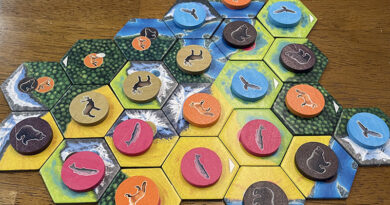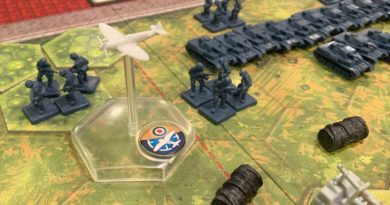Magnate: The First City board game review
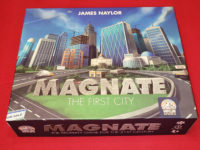
“Welcome to Humbleburg, a sleepy commuter community that has resisted development for years. That is until one fateful city council meeting where everything changed in the blink of an eye. Developers from all over raced to Humbleburg to make their fortunes in this small town. Will you be one of them?”
In Magnate: The First City players take on the role of developers who buy land, develop it, and lease space to tenants. But nothing lasts forever and sooner or later the bubble will burst.
The player who can manage their properties the best and sells at the right time will be victorious.
How to play Magnate: The First City
The first time you play Magnate, you’re encouraged to use the super helpful tutorial deck that’s included in the game. It guides you through several turns of the game so you can learn all the different nuances of the game play.
Setup
The City Center tile is placed in the center of the city board and 6 random City tiles placed around it. Buildings and Tenants are then added to the City Center tile to create the starting residents of Humbleburg.
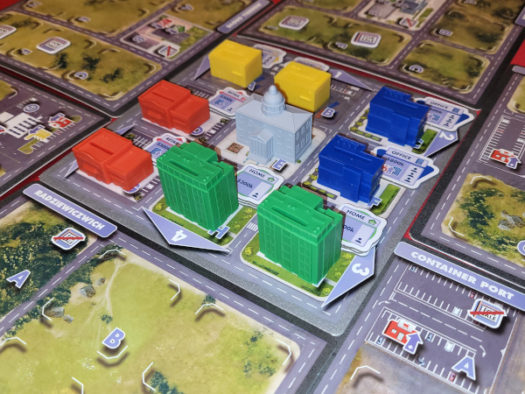
For Sale tokens are drawn randomly and placed on a number of lots based on the number of players. These lots will be available for players to purchase in the first round.
The Property Market board, corresponding to the number of players, is then set up with the following markers on their start position of their respective track: Land Price, Crash, and Turn Order. The Tenant tokens are added to the available tenant locations.
Next, the New Tenant and Risk decks are shuffled and placed face-down near the Property Market board.
All money, dice and advertising tokens are also placed near the Property Market board. There are great plastic inserts that come with the game that makes the organization of these items a breeze.
Each player receives all the Ownership tokens and a Money Wallet with the matching company logo. They also receive 4 advertising tokens, $2 million in cash, and 2 player aids each.
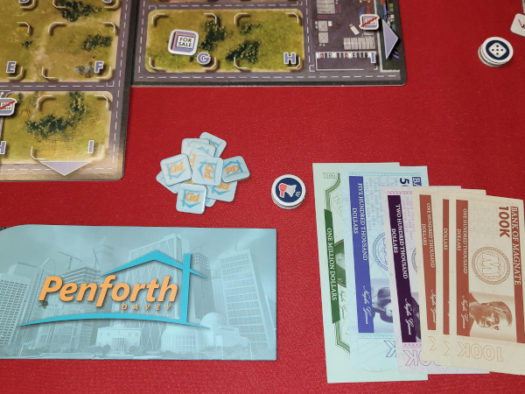
The first player receives the really cool excavator toy that’s used as a first player token, and the game is ready to begin.
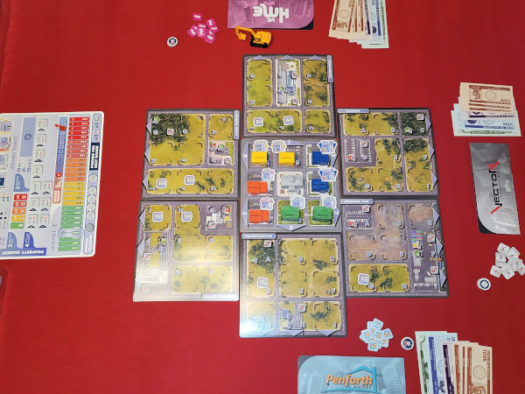
Game Play
A game of Magnate: The First City is played over several rounds, with each round consisting of the following phases:
I. Turn Order Bidding
In this phase, players bid to be 1st in turn order. Starting with the player to the left of the current starting player and going around clockwise, players choose to bid or pass. This continues until all players but 1 have passed. The bid amount from the winning player is then paid to the bank. Winning this bid can be important for many reasons including being first to purchase a lot or to gain a tenant of a certain type.
II. Attract Tenants and Collect Rent
To attract tenants to a player’s vacant building(s), they roll and resolve a number of dice based on a formula and chart found in the rule book. This is probably the trickiest part of the game but it’s explained well in the rule book and on player aid cards.
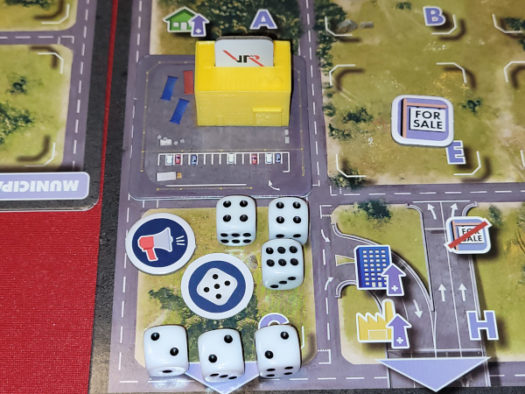
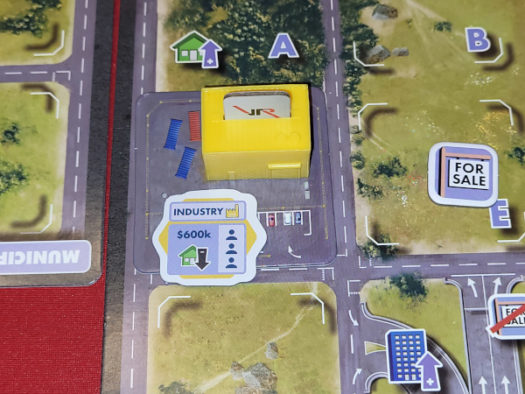
III. Player Actions
Beginning with the first player and going clockwise around the table, players take 1 of the following actions.
Buy a lot
This is just what it sounds like. A player may buy one of the plots of land which are marked by the For Sale tokens. The cost is the current land price indicated on the Property Market board.
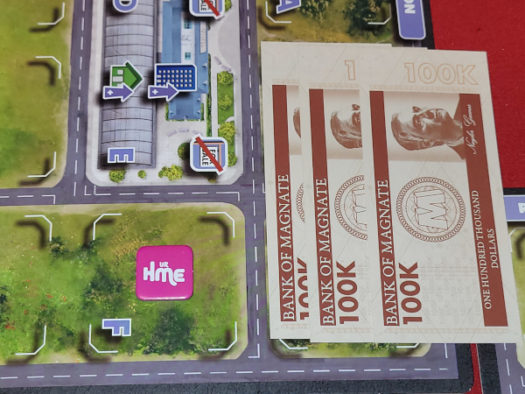
Build or Rebuild on an existing lot
When a player takes this action, they choose a building they want to build and pay the construction cost (noted on the player aid) to the bank. They take a footprint card matching the building, adding it to the lot they’re building on, place the building down, and add one of their ownership tokens to the building.
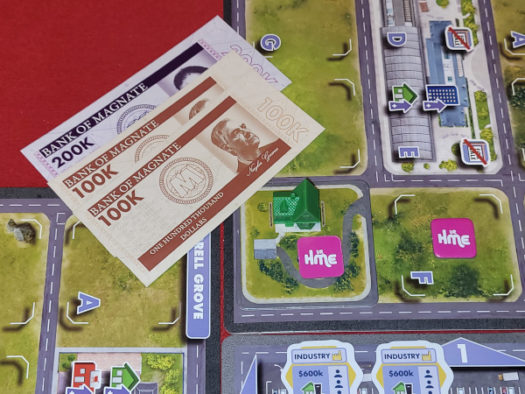
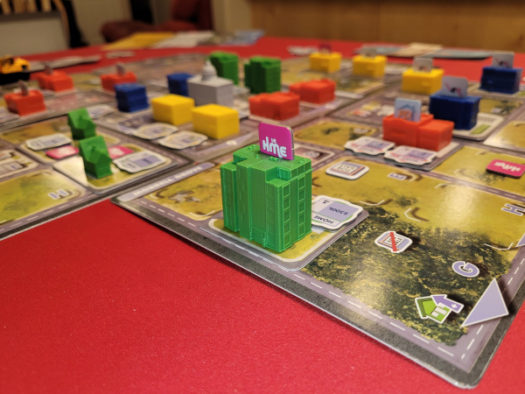
Sell existing buildings and properties
To sell a property, a player uses a simple formula and chart found in the rule book to determine the sell price. They then gain that amount from the bank and remove their ownership token from the building, returning it to their supply.
Advertise
For this action, players receive two advertising tokens for free. They can buy additional tokens for $500k each. These tokens are used during the Attract Tenants phase of the round and can be extremely important.
Consult
When players take this action, they gain money from the bank equal to the current land price, as noted on the Property Market board. Who can’t use a little extra cash?
Players continue taking actions until each player has taken 3 turns.
IV. Property Market
After players have taken their actions, the Property Market is adjusted for the changes made during the player’s turns. Players go step-by-step through the board and resolve the different parts.
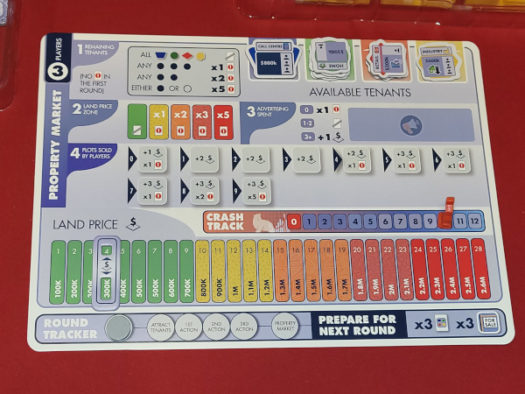
1) Available Tenants
Based on the number of different types of available tenants in the tenant pool, players may have to draw 1 or more Risk cards. These cards can move the Crash marker closer to the end of the game and cause the end game land price to drop as well.
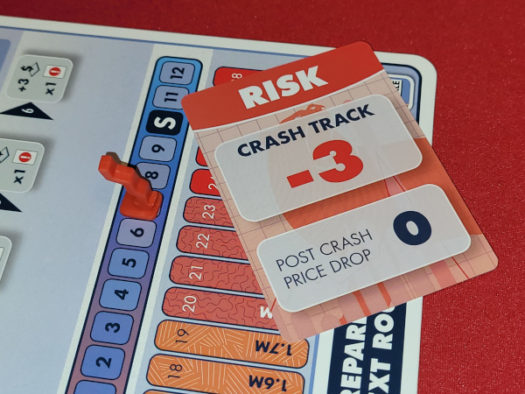
2) Land Prices
Based on the current land price, players may have to draw a number of Risk cards.
3) Advertising Spent
Based on the number of advertising tokens spent, players may have to draw a number of Risk cards or adjust the land cost.
4) Sold Property
Based on the number of properties sold in the round, players may have to increase land costs and/or draw Risk cards.
5) Prepare for the next round
Here players draw New Tenant cards, adding new tenants to the tenant pool as indicated. Finally players add new For Sale tokens to the city.
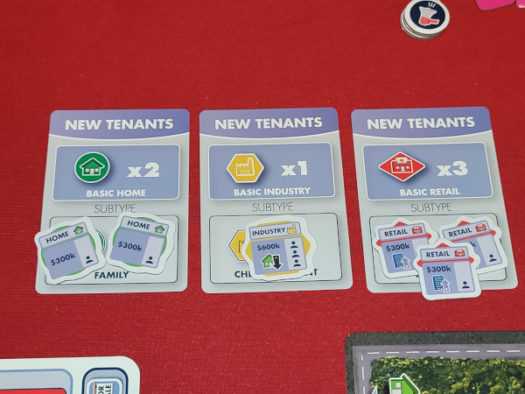
The game ends when the Market Crash track reaches 0 and the Property Market phase has ended.
Players then determine how deep the crash is by adding up the bottom number on each of the drawn Risk cards and subtracting that number from the current land price. Players sell their properties based on the newly adjusted price and the player with the most money wins.
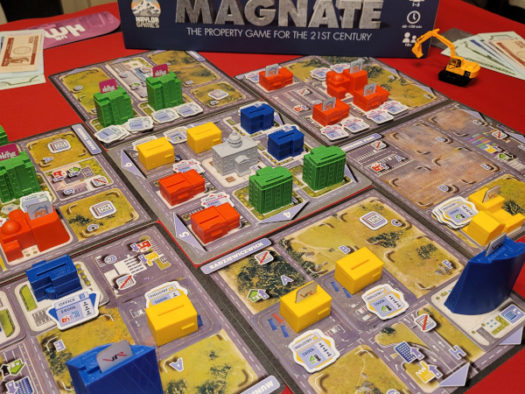
There’s also an Advanced Tenant game mode where the tenants have subtypes. Basically, players use the non-standard side of the Tenant tokens. This adds flexibility to the types of tenants players attract each round, adding more variety and competition to the game.
There’s also a solo mode, but I haven’t been able to play it yet. Hopefully I get to do that soon.
The Breakdown
Another city builder, yahoo!
Magnate: The First City’s tagline is “The property game for the 21st century” and I would have to agree. The meld of an old game idea and newer game mechanics really comes together to create a compelling and entertaining game.
Theme and Mechanics:
The theme is obviously city building and property management and the mechanics really help solidify this. There’s action selection, a little bit of area control, resource management, auctioning, and dice rolling which all combine to make a glorious real-estate game symphony.
This includes how land becomes available or not available in some instances which can cause a land rush at times. Another is the fact you can sell your properties throughout the game in order to finance other projects which adds to the realism.
The factors that reveal the Risk cards and drive the market towards the bubble are also very realistic and the selloff at the end is very reminiscent of 2006-07.
One mechanic that doesn’t hold true for me is the selling of property and not taking the size of the building into consideration. For example, a house gets you the same value as an apartment building. So it may help during the rent collection phase to have the bigger buildings, but for selling it makes no difference.
This in no way detracts from the game and could even be something a house rule takes care of.
The sell off at the end of the game is predictable, but the timing of it is not. The Risk cards can drop the Crash meter anywhere from 0 to 3 spaces. So while you may know the number of Risk cards that will pop up between rounds, you’ll never know just how far the meter will move. This mechanism adds a lot of suspense towards the end of the game.
Flow and accessibility:
The way the rules are laid out and the phases are structured really makes Magnate easy to learn and play. Don’t get me wrong, there’s a solid learning curve here and it will still take a couple of hours to play, but there isn’t a whole lot of downtime between player actions, so things move quickly.
The biggest slowdowns occur during the Attract Tenant phase and the Selling action–where players have to refer to the rule book and do a little math to resolve. Once you play enough games, this becomes a lot easier and faster.
Although this is a meatier game, it didn’t stop my youngest, age 7, from joining us for 2 games, and winning one of them (with just a little help)!
Despite that, I think the box is right with the 10+ age recommendation.
Production Value:
The production value of Magnate gets a hearty A+.
Everything looks great and is high quality. Considering I got to review the prototype, which was amazing, this didn’t surprise me.
The miniature buildings are wonderfully detailed and create quite the table presence which is sure to turn heads at any gaming event.
The materials used for all the other components are standard fair. The chipboard for the tokens is a good thickness, and materials for the City boards, Property Market board, etc are good quality. The one drawback I have is the money–which is paper. However, it’s not thin cheap paper. It is better quality, but the problem is it can still get wrinkled and bent when hastily grabbing. Again, not a deal breaker.
There’s little artwork, but what there is looks great. My only hesitation again falls to the money. It looks like there are portraits of people on the money, but I have no clue who they are. Maybe backers from the KS campaign?
As usual, I love the inserts. They make setting up, game play, and takedown so much easier. I wish more companies would pay just a little more attention to this detail. I was playing a Fantasy Flight game the other day and went to put it away but I couldn’t fit the components back into the narrow slot available for storage. You can take those out, but why have them in the first place?
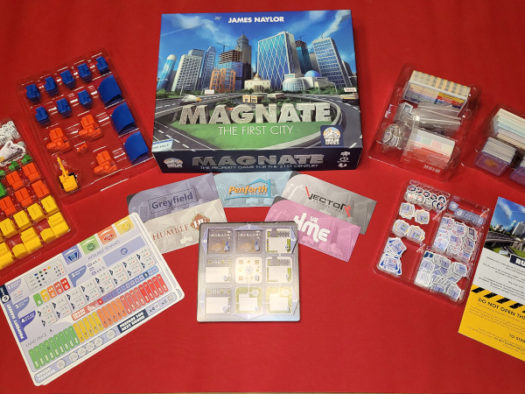
How does Magnate: The First City score on our “Let’s Play Again” game meter?
Like I said earlier, this is a heavy game that takes a good 2+ hours to play and that’s normally not a type of game my family enjoys. But that’s not the case here! We love it and the boys ask for it time and time again, as do I.
If you like simulation, city builders, or economic style games Magnate: The First City is a must grab.
About the Author
Dane is an Advertising and Layout Manager for a national magazine by day and a husband, father of four, and board gamer by night (and mornings). He has a passion for board games and believes board games help bring families closer together while providing kids a unique way to learn many diverse skills. And he thinks they’re downright fun!!!
The Board Game Family would like to thank Naylor Games for a review copy of Magnate: The First City.



